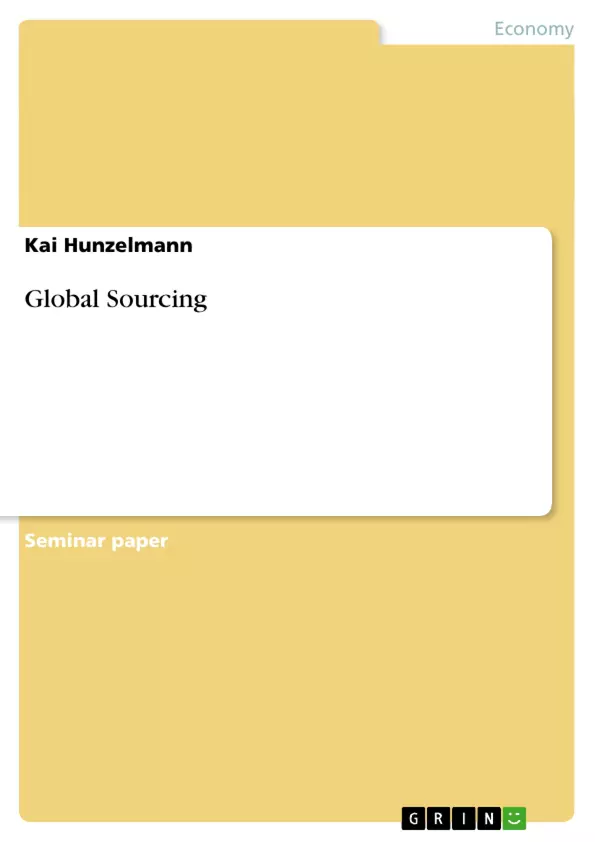In times of “lean-production” and globalisation it’s not just the output-markets that profit from those trends, it’s also the input market which is heavily influenced by the movements towards a worldwide orientated economy. This development is promoted by new and innovative transportation-, packaging- and stock concepts as well as by improving conditions in telecommunication and the successive fall of trade barriers especially within regional economies like the EU or NAFTA.
Content:
Introduction
1. Definitions
2. . Context of global sourcing
a. branch specific context
b. company specific context
3. Strategic Concept
a. Targets of global sourcing
b. The Types of procurement
c. The choice of regions
d. The quantity of sources
4. Organisation
a. Organisational structures
b. Centralisation Vs Decentralisation
5. Chances and risks
6. Current development
Introduction
In times of “lean-production” and globalisation it’s not just the output-markets that profit from those trends, it’s also the input market which is heavily influenced by the movements towards a worldwide orientated economy.
This development is promoted by new and innovative transportation-, packaging- and stock concepts as well as by improving conditions in telecommunication and the successive fall of trade barriers especially within regional economies like the EU or NAFTA.
1. Definitions
The term purchasing or procurement is used throughout all stages of businesses. Representative to a variety of definitions, we chose the following descriptions to define this process: “ Purchasing subsumes all actions, that have the same target, to supply the company’s processes with not-self-produced goods.”
The objects that should be counted to those goods are generally described as: ”asset, human resources, equipment, raw materials and information.”
The global sourcing term is as well known as “international purchasing” or worldwide sourcing” and describes the “adjustment of the purchase policy of companies towards the worldwide existing purchasing markets.”
In nowadays the distinction of international purchasing and international production is quite difficult. Thus, we’ve tried to examine more closely the international production next to the classical “purchasing abroad”, long-term co operations or joint ventures as variety of global sourcing.
2. Context of global sourcing
2.1. branch specific context
In this chapter we I discuss the branch specific contextfactors. Thereby the authoritative characteristics of production and competition are specifically worked out.
2.1.1. The production
A branch is defined through the product a group of companies is producing and selling. An analysis of possible determination factors of international purchasing requires to examine the following processes:
- The depth of production including the make or buy decision
- Cost structures
- Technical complexity
2.1.2. The competition
Another very important measure to the decision of international procurement is the situation between the competitors on common markets. Generally we distinguish between intensity and pattern of competition. According to the 5-forces model by M. Porter the intensity of competition is the result of the “new entering competitors in the market”, “rivalry of established competitors”, “ danger of substitutes”, “demand conditions and supply conditions”.
The pattern of competition is meant by the importance of price, quality or time-criteria that determine targets like costs, quality standards or the improvement of performance.
2.2. company specific context
The company specific measures according to international purchasing are for example the size of the company or the “product-market-combination”
2.2.1 The company size
From special meaning to fulfil the requirements of tasks of international procurement are specialised staff, assets and international experience. The availability of those resources is mainly determined by the size of a company. The organisation of large companies is mainly characterised through “division of labour” which allows to set-up experienced specialist. Furthermore the procurement of capital for smaller companies is tending to be more complicated in comparison to larger firms
2.2.2 The product-market-combination
The product-market-combination is primarily the realisation of the marketing-strategy on the target-markets. It is characterised by the mixture of various products of a company and the referring markets that are delivered. There could be a segmentation of markets for example from lowest prices to highest prices or from little-quality to high-quality.
3. The strategic concept
This chapter is about the strategic components of international purchasing. We discuss the targets of global sourcing and what types of procurement in which regions and with how many sources are the most profitable.
3.1. The targets of global sourcing
illustration not visible in this excerpt
Table 1: targets of global sourcing
[...]
- Arbeit zitieren
- Kai Hunzelmann (Autor:in), 2000, Global Sourcing, München, GRIN Verlag, https://www.grin.com/document/10460



